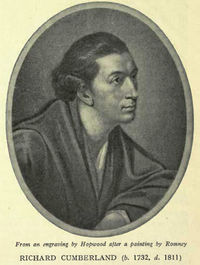Annotation:Country Attorney (The)
X:1 T:Country Attorney, The M:2/4 L:1/8 R:Country Dance B:Samuel, Ann & Peter Thompson -- Compleat Collection of 200 Favourite Country Dances, vol. 5 (1788, p. 2) Z:AK/Fiddler's Companion K:G G>G (3BAG|F>G A2|B>B (3dcB|(3ABG (3FED| G>G (3BAG|F>G A2|(3BcB (3AGF|G2 G,2:| |:g>ee>g|f>d (3dcB|e>cc>e|d>B (3BAG| c>AA>c|(3Bdc (3BAG|(3AcB (3AGF|G2 G,2:|]
COUNTRY ATTORNEY, THE. English, Country Dance (2/4 time). G Major. Standard tuning (fiddle). AABB. The Country Attorney was a comic play by Richard Cumberland (1732-1811), staged at London's Theatre Royal in the Hay-Market, July 7th, 1787. Unfortunately, it was not well received and ran only a half-dozen nights. Cumberland reworked much of the same material a few years later for his The School for Widows (1789). He was not regarded in the first rank of playwrights, even by his peers.

Thomas Davis acerbically dismissed him:
Mr. Cumberland is unquestionably a man of very great abilities; it is his misfortune to rate them greatly above their value.
Country dance directions appear in Nancy Shepley's Book, a small copybook of dance figures compiled by Nancy Shepley of Pepperell, Massachusetts, c. 1794.
The tune is in 2/4 time in the London publications from Longman, Lukey & Broderip and the Thompsons. It was converted to 6/8 time in the mid-19th century music manuscript collection of Manchester, England, musician biography:John Roose, with the title "Country Assembly"[1]
- ↑ The title "Country Assembly" is probably a mishearing of "Country Assembly", or a misreading of the handwritten title in the manuscript. The tune is also contained in the mid-19th century music manuscript of William Winter (1774-1861), a shoemaker and violin player who lived in West Bagborough in Somerset, southwest England.

